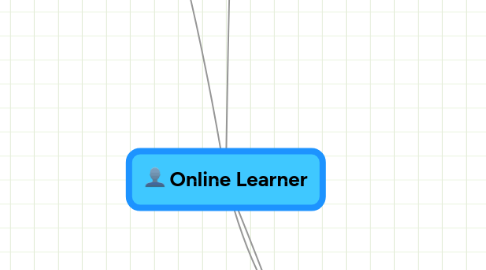
1. Learner Characteristics
1.1. communicate
1.1.1. synchronous
1.1.1.1. meeting rooms (Adobe Connect)
1.1.1.2. voice over IP (Skype)
1.1.1.3. "live text" chat
1.1.2. asynchronous
1.1.2.1. writing
1.1.2.2. text chat
1.1.2.3. discussion forums
1.1.2.4. email
1.2. willing to "speak up"
1.2.1. confusion
1.2.2. difficulty
1.2.3. frustration
1.3. responsible
1.3.1. self-motivated
1.3.1.1. work independently
1.3.1.2. complete readings
1.3.1.3. participate
1.3.1.4. complete assignments
1.3.2. committed
1.3.2.1. participate 3-5 days a week
1.3.2.2. post questions
1.3.2.3. respond to questions
1.3.2.4. family support
1.3.3. self-disciplined
1.3.3.1. 5 to 10 hrs/week/course
1.3.3.2. respectful
1.3.3.3. polite
1.4. open minded
1.4.1. non-traditional learning
1.4.2. believe in online learning
1.4.3. technology issues
1.4.4. flexible
2. Learner Strategies
2.1. learning contracts
2.1.1. what will be learned
2.1.2. evaluation criteria
2.1.3. time frame
2.1.4. how learning accomplished
2.2. small group work
2.2.1. discussions
2.2.2. guided design
2.2.3. role play
2.2.4. games
2.2.5. problem solving
2.3. discussion
2.3.1. interactive
2.3.2. analysis
2.3.3. critical thinking
2.3.4. participatory learning
2.4. project
2.4.1. special interests
2.4.2. practical experience
2.4.3. simulations
2.4.4. case studies
2.4.5. collaboration
2.4.6. brainstorming
2.5. lecture
2.5.1. educator is expert
2.5.2. disseminate information
2.6. collaborative learning
2.6.1. learn together
2.6.2. differing abilities
2.6.3. construct knowledge
2.6.4. responsiblility
2.7. self-directed learning
2.7.1. learner directed
2.7.2. self paced learning
2.7.3. learner initiated
2.8. case study
2.8.1. past experiences
2.8.2. participatory
2.8.3. relevant case
2.8.4. link to future experiences
2.8.5. practical thinking
2.9. mentorship
2.9.1. learner development
2.9.2. drawing from prior knowledge
2.9.3. guided learning
2.9.4. modeling
2.9.5. interpreting
2.9.6. support
2.9.7. provide vision
2.9.8. challenge
2.10. forum
2.10.1. open discussion
2.10.2. moderator
2.10.3. audience
3. Learning Styles
3.1. Approaches
3.1.1. Constructivism
3.1.1.1. world
3.1.1.1.1. personal reality
3.1.2. Cognitive Approach
3.1.2.1. internal & reflective
3.1.2.1.1. memory
3.1.2.1.2. thinking
3.1.2.1.3. motivation
3.1.3. Behaviorist approach
3.1.3.1. observable change
3.1.3.1.1. external stimuli
3.2. Styles
3.2.1. visual/verbal
3.2.1.1. writing
3.2.1.2. visual aids
3.2.1.3. quiet environments
3.2.1.4. class notes
3.2.1.5. textbooks
3.2.2. visual/nonverbal
3.2.2.1. pictures
3.2.2.2. quiet environment
3.2.2.3. artistic
3.2.2.4. film, video
3.2.3. auditory/verbal
3.2.3.1. aural learner
3.2.3.2. group discussion
3.2.3.3. interaction
3.2.3.4. audio tape
3.2.3.5. lectures
3.2.4. tactile/kinesthetic
3.2.4.1. participatory learner
3.2.4.2. field work
3.2.4.3. demonstrations
3.2.4.4. physical/hands on
4. Skills
4.1. Weaknesses
4.1.1. access to equipment
4.1.1.1. computer
4.1.1.2. Internet
4.2. Strenghts
4.2.1. quality input
4.2.2. think ideas through before responding
4.2.3. use technology
